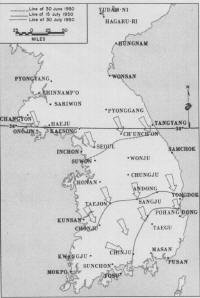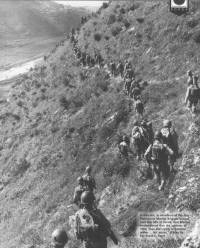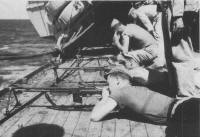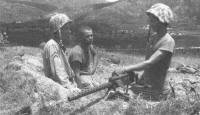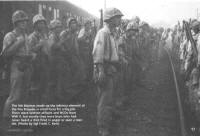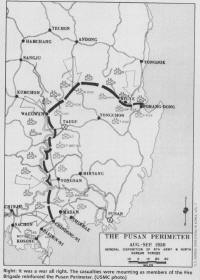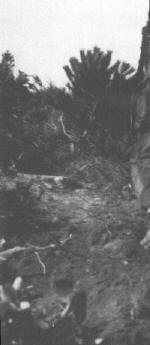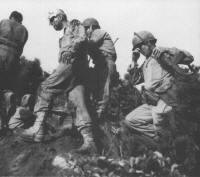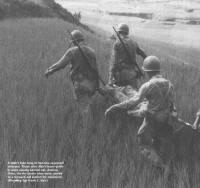 |
||||
 |
||||
Gene Dixon Memoir |
||||
|
||||
Send in the "Fire Brigade" |
||||
PART ONE |
||||
| Allan C Bevilacqua. Leatherneck. Quantico: Jul 2000.Vol. 83, Iss. 7; pg. 14, 8 pgs Copyright Marine Corps Association Jul 2000 |
||||
|
It was hot in Korea in August of 1950, hot and humid. The morning appearance of the sun above the jumbled hills that make up the bulk of the Korean landscape signaled the start of the daily race between the temperature and the relative humidity to see which could be first to reach the 100 mark. By midday the lower half of the Korean peninsula was a vast steam bath. Long years afterward, a Marine who served in the First Provisional Marine Brigade that first summer of the Korean War would remember it this way: "It was like trying to breathe water ... hot water."
In the Marine brigade's infantry element-the Fifth Marine Regiment-the soaring heat and stifling humidity made for particularly rough going. Save for those Marines hastily joined from posts and stations up and down the West Coast, the 5th Marines had been together at Camp Pendleton, Calif., for a year and more.
Under the watchful eye of the regimental commander, Colonel Victor H. Krulak, they had trained to a high state of preparedness, toiling over Horno Ridge until they knew every ripple, splashing ashore that spring at Del Mar in Exercise Demon III, conducting countless small unit exercises at the company level. Krulak was gone now, transferred to the post of G-3 (Operations), Fleet Marine Force, Pacific, in Hawaii. Taking the 5th Marines into combat would be Lieutenant Colonel Raymond L. Murray, a decorated combat veteran of the war in the Pacific.
It may be that the Marine Corps never sent a better trained regiment to war, but California's arid climate had not prepared the men in the rifle companies for the suffocating blast that greeted them as soon as they arrived in Korea. The regiment's first casualties had been heat casualties, men with chalk-white faces and sweat-blackened clothing, who first stumbled and then sagged into the dust of the roadway, the fiery heat in their bodies trapped there by the sponge like atmosphere that draped itself on them like a wet overcoat. The situation was critical, and there was a job to be done.
Barely more than seven weeks earlier, at 0400 on Sunday, 25 June, North Korea's communist dictator, Kim Il Sung, had sent his so-called North Korean People's Army (NKPA) crashing across the 38th parallel that separated the two Koreas. Vastly outnumbered, the Republic of Korea (ROK) Army-little more than a lightly armed force of border guards-was ground under and swept aside. American reinforcements, rushed hastily from garrison duty in Japan, fared little better. Inferior in tanks and artillery, their numbers no match for the nine well-equipped divisions confronting them, the Americans and South Koreans were pushed steadily backward. desperately trading space to buy time.
By late July, the NKPA held all of South Korea save for a small pocket of the southeast coast, and they were closing in for the kill before help could arrive.
Help was on the way. At military bases throughout America, units were shipping out. First among them was a small brigade of leathernecks, the First Provisional Marine Brigade, commanded by Brigadier General Edward A. Craig, one of the Marine Corps' most respected officers. Essentially the 5th Marines, reinforced, the brigade was a small force for a big job.
The gutting of the armed forces in the years following World War II had left the Marine Corps-like all of America's military establishment-little more than a skeleton. The proud First Marine Division existed mostly on paper; only one of its infantry regiments, the 5th Marines, was able to actually put men in the field. There were precious few of them. Each of the 5th Marines' three infantry battalions could muster only two rifle companies and a weapons company. That was all there was. It would have to do.
Fortunately, battles often turn on things other than numbers. Just as important are factors like esprit de corps, gritty toughness, solid training and high confidence. The 18-, 19- and 20-year-olds, none of whom had ever seen combat, who made up the bulk of the brigade's numbers had those things in spades. Beyond that they had the added advantage of being led by officers and staff noncommissioned officers who were almost entirely veterans of the war against Japan-men who had fought battles as ferocious as anything on record in any war. Taken together, these qualities would produce a fighting spirit that would eventually bring the Marine brigade a memorable nickname: the Fire Brigade.
They started earning that name almost as soon as they stepped ashore at the port of Pusan. Fully aware that Pusan was absolutely essential to the American and South Korean forces clinging tenaciously to their small corner of Korea, the NKPA leadership was even then planning an all-out offensive to capture Pusan and drive the defenders into the sea. The key element of that NKPA offensive was to be an attack by the veteran 6th Infantry Division, reinforced by the 83d Motorized Regiment. The first stage of the attack, the capture of Sunchon, was realized on 28 July. Flush with success and confident of victory, the commander of the 6th Div issued the following general order:
"Comrades, the enemy is demoralized. The task given to us is the liberation of Masan and Chinju and the annihilation of the remnants of the enemy. Comrades, this glorious task has fallen to our division! Men of the 6th Division, let us annihilate the enemy and distinguish ourselves!"
Something its commander hadn't anticipated, something that planned to strike first, was waiting for the 6th Div.
Even as the Marines were filing ashore on 2 Aug., Army Lieutenant General Walton Walker, commander of American forces in Korea, had decided to call a halt to trading space for time. As a practical matter there was no more space to trade. Ready or not, friendly forces could no longer cede the initiative to the enemy; they must attack.
That task would fall to the Army's 5th Regimental Combat Team (RCT) and the newly arrived Marine brigade. The Marines saw precious little of Pusan. Almost as soon as they set foot ashore, they were hurried southwestward to Masan and the final pre-attack staging area of Chindong-ni. D-day was set for 7 Aug., eight years to the day after Marines had launched America's first offensive action against Japan at Guadalcanal.
The first contact with enemy forces was not long in coming. The mission fell to LtCol Robert D. Taplett's 3d Battalion, 5th Marines. During the afternoon and evening of 6 Aug., the battalion, the brigade's lead element, had established itself on the hills astride the vital main supply route (MSR) leading back to Pusan. Shortly after midnight, as a new day was beginning, Taplett was ordered to send a platoon to relieve a hard-pressed company of the 5th RCT holding a dominating height shown on the battalion's maps as Hill 342.
In short order Second Lieutenant John H. "Blackie" Cahill's 1st Platoon of Company G was making its way through the darkness to the base of the hill just west of the MSR. There, on the advice of the Army guide, the platoon waited for dawn to break.
With the dawn came the heat. The struggle up the near-vertical hill was exhausting, and heat casualties weren't long in coming. Long-range automatic weapons and mortar fire added to the number of fallen, as the NKPA extended its official welcome to the Marine brigade. What Cahill found at the summit was a siege straight out of the Old West. Enemy forces ringed the Army perimeter on three sides. Relief was out of the question. It would take every soldier and Marine on the hill to prevent it from being overrun.
Cahill began feeding his men in among the badly depleted Army defenders. Of the 52 members of the platoon who had set out only hours before, only 37 reached the crest. Among the wounded were Cahill's platoon sergeant, Staff Sergeant Robert Robinson, and his platoon guide, Sergeant Thomas Blackmon. Blackmon struggled to reach Cahill's position, but his wounds would prove fatal.
"We were situated on the front slope of the hill, sitting there like ducks in a shooting gallery," remembered Cahill. "Once we climbed into our holes, we couldn't get out of them. The North Koreans really had us zeroed in. The heat just baked us. Then the water ran out. Some people went down with canteens and came back with rice-paddy water. As a result, we all ended up with worms. Hell, in that oven we were so thirsty we'd have drunk anything."
Heat and thirst, as bad as they were, were the least of the problems facing the defenders of Hill 342. Swarms of enemy infantry scrambled up the steep slopes of the hillside under a vicious supporting fire of machine guns and artillery. Fighting furiously, the Marines and soldiers fought off each rush. But the North Koreans were extending their lines, steadily attempting to complete the encirclement of the hilltop.
Friendly casualties were mounting, most ominously among Cahill's automatic riflemen. The Browning Automatic Rifle (BAR) was the backbone of the Marine fire teams. For one to be put out of action was a serious loss of firepower. To attempt to go from one fighting hole to another to keep a BAR in action was to flirt with death. None of Cahill's Marines hesitated when the need arose. The BARs kept firing.
By late afternoon it was becoming apparent that the North Koreans were launching a determined effort to eliminate the defenders of Hill 342 and cut the MSR before the Marines could launch their own attack. As soon as LtCol Harold S. "Hal" Roise's 2/5 began arriving, orders were issued to reverse the situation. Captain John Finn's Co D and First Lieutenant William Sweeney's Co E were to relieve the defenders of Hill 342 and seize the remainder of the height. After spending the night halfway up the hill, Finn led his company to the beleaguered defenders as the sun rose for another scorching day.
Within minutes of relieving Cahill and the Army defenders, Co D ran directly into a buzz saw. Hordes of North Korean infantry, each man seemingly firing a "burp gun" (the Soviet-made Model 1943 PPSh 7.62 mm submachine gun), launched the heaviest attack yet. Finn went down wounded. His executive officer, 1st Lt Robert T. Hanifin, assumed command, only to be felled by the blazing heat-his face the clammy, ashen mask of heat stroke.
In the normal course of things, command would have fallen to the senior platoon leader. By this time not a single platoon leader was left standing. Second Lieutenants Arthur A. Oakley and Wallace J. Reid fell dead. Reid's death was especially hard on Private First Class Doug Koch. Koch, a BAR man, had come to know Reid, an enlisted Marine in WW II, and liked him for his evenhanded fairness. How terrible it would be for Reid's wife and two young sons, Koch thought.
The attacking North Koreans kept up an unrelenting fire, bullets and grenades flying through the air in showers. Shouting wildly, they came on, submachine guns blazing. Second Lt Edward Emmelmann, the company's remaining platoon leader, was felled with a serious head wound. PFC Armando DeLeon saw him fall and thought him dead. Only years later did DeLeon learn that Emmelmann survived his wound. Master Sergeant Harold Reeves, a hard-bitten veteran of nearly 30 years of service, assumed command of Co D.
Right: It was a war all right. The casualties were mounting as members of the Fire Brigade reinforced the Pusan Perimeter.
Standing firm beside Reeves was 2dLt Douglas Wirth, a forward observer with 1/l 1. With sheer willpower they held the situation in hand. Together the old sergeant and the young officer ranged the firing line, striding along as calmly as though they were back on the rifle range at Chappo Flats on base at Camp Pendleton. Directing the company's fires, Reeves heartened the younger Marines by his very presence. Wirth, who had assumed control of all available air and artillery assets in the area, brought devastating fires to bear on the massed attackers.
Wave after wave was stopped in its tracks, shredded by a hail of steel. Buzz saws can cut two ways. Slowly, painfully, the thinning ranks of Marines on Hill 342 gained the upper hand, and in the process they took a good bite out of elements of the NKPA 6th Div's 13th and 15th Regts.
By nightfall, Hill 342 was entirely in Marine hands, its possession uncontested. And PFC Koch would get an introduction to an aspect of combat that isn't even hinted at by the movies or television. Detailed to bring in the bodies of dead Marines, he recalled: "I learned that day about the smell of death. A dead person smells different than a dead animal, and the smell is something you never forget. It's something that can't be put on television or in newsreels. They can capture the sounds and some of the confusion of battle, but the smell of death is something you can't record."
One by one the bodies of the dead Marines were brought to the company command post to await the arrival of graves registration personnel. The dead North Koreans lay where they fell. There were somewhere in the vicinity of 400 of them.
To the east, across the MSR, on the lower slopes of Hill 255, the bodies of other North Koreans lay sprawled where they fell. Like the attack thrown against D/2/5, this assault began early on 8 Aug. That was when the Marines of Capt Joseph C. Fegan's H/3/5 observed a column of troops climbing the southern slopes of Hill 255 from the direction of the road leading north from Chindong-ni to Haman. At first it was thought the newcomers were ROK troops, but when they began setting up facing Fegan's position all doubts vanished. The figures in the distance were North Koreans, another prong of the 6th Div's thrust to sever the MSR. Almost immediately they opened fire.
Apprised of the situation, LtCol Taplett ordered Fegan to attack the incursion at once, before the intruders could solidify their position. Second Lt John O. Williams led his 1st Plt to the long tableland separating the two forces. Pushing aggressively over the open ground, the platoon closed to within 30 yards of the enemy force, Marines firing from the hip as they went forward. Showers of hand grenades and a rain of machine-gun fire halted them and pinned them there. Williams tried to work some of his men around the dank of the enemy position, but the terrain effectively blocked them. The attack was bogged down.
One day in the future, Joe Fegan's shoulders would carry the three stars of a lieutenant general. Among the qualities that would put them there was a fierce battlefield combativeness that refused to permit any obstacle to stand in its way... that and an ability to get out in front and lead when it was needed. Ordering Williams to withdraw to the original line of departure, Fegan personally led his 3d Plt through the ranks of Williams' men, striking directly for the rocks that sheltered the enemy machine-gunners. Artillery and air wouldn't help. It was a fight that was going to be settled man to man, up close and personal.
Fegan had men like Corporal Melvin James, who drove his squad deeply into the flank of the North Korean unit, killing every man who resisted. Company Gunnery Sergeant Ray Morgan and PFC Donald Terrio each blasted an enemy machine-gun position into smoking rubble and blood-soaked corpses.
One fighting hole at a time, the 3d Plt shot and hacked its way through the rocky summit. The North Koreans fought to the bitter end, until every one of them lay dead, and Fegan's men had rolled forward another 200 yards to where the ground sloped away for a space before rising to the hill's full height.
Ordered to dig in and hold what they had, the Marines of Co H settled in for the night under a shield of mortar and artillery fire that pummeled North Korean reinforcements attempting to regain a foothold on the northern slopes of the hill. Throughout the night of 8 Aug. and into the pre-dawn hours of 9 Aug., the 105 mm howitzers of 1/11 and the 3d Bn's 81 mm mortars laid down a rain of fire in front of the 3d Bn's lines. The enemy received a thorough beating prior to Co H's attack scheduled for the morning of the 9th.
At 0830 on 9 Aug. the fire increased to a crescendo. Artillery and mortar shells rained down on the heights of Hill 255 in a torrent. When the fire slackened, Vought F4U Corsairs of Marine Aircraft Group 33 swooped low to plaster the defenders with bombs, rockets and napalm. Joe Fegan's Marines jumped off right on time. Minutes later, after encountering only negligible resistance, they were at the top. The only North Koreans there with them were dead.
The tide had turned. The NKPA 6th Div, that only days before had entertained visions of "annihilating" the enemy, had had a belly full. From all indications, the North Koreans were pulling back. Gen Craig had no intention of permitting them to leave unmolested. It was time to crowd them, to batter them senseless, like a good boxer going for the kill when he has his opponent stumbling on rubber legs.
[Author Affiliation]
Editor's note: Maj Bevilacqua, a frequent contributor to Leatherneck, is a former enlisted Marine who served in the Korean and Vietnam wars. As an officer, he was an instructor at Amphibious Warfare School and Command and Staff College, Quantico, Va.
Reproduced with permission of the copyright owner. Further reproduction or distribution is prohibited without permission.
Subjects: Military history, Korean War
Locations: United States, US, Korea
Companies: Marine Corps-US (NAICS: 928110 )
Article types: Feature
ISSN/ISBN: 0023981X
| Close this window |
|
© 2002-2016 Korean War Educator. All rights reserved. Unauthorized use of material is prohibited. - Contact
Webmaster with questions or comments related to web site layout. |

